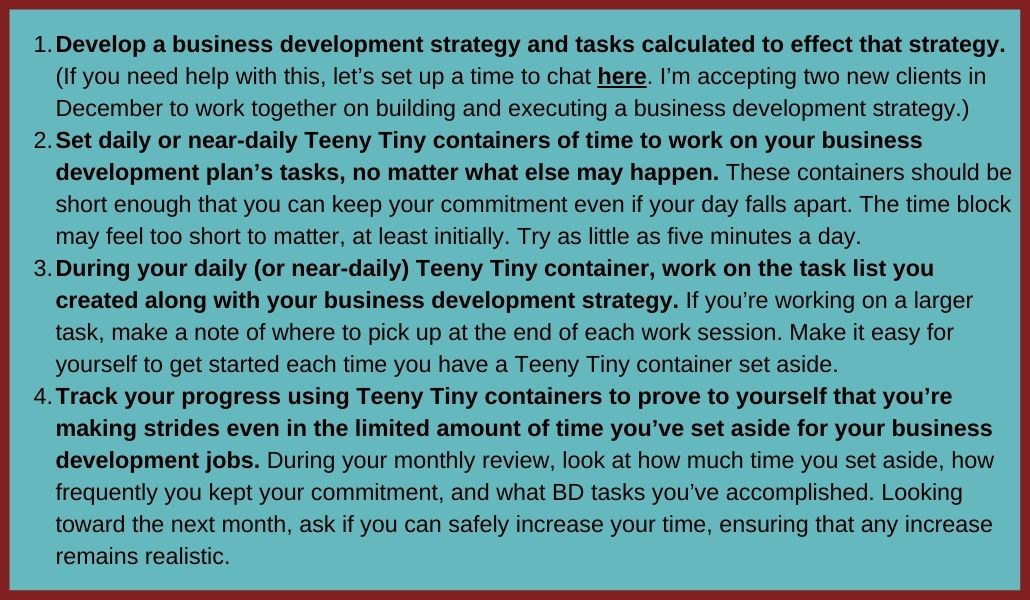Setting Aspirational Plans?
Nearly two years ago, I began spending time on creative writing for the first time in many years. I certainly wrote while I was practicing law — memoranda and briefs galore! —and I’ve written voluminously for my business (The Reluctant Rainmaker, among other books and articles) and for the nonprofit I founded. But this kind of writing is different: it’s something I want to do, it’s a bridge to a future that I want to live, and it’s something with no urgency whatsoever.
Does that remind you of the definition of business development? Your situation might be different: particularly if you’re a sole practitioner, if you’re working in an eat-what-you-kill firm, or if you’ve lateraled (or merged) into a new firm and need to establish yourself, business development may be not just urgent, but also important. For many lawyers, though, business development activity is calculated to reach important professional and personal goals, but it isn’t urgent.
That’s exactly why it’s important that you set your schedule so that you have dedicated daily or near-daily time for business development work. In the absence of outside motivation, your commitment to the time you set aside on your calendar may be the only thing that ensures you move forward on your BD activity. Of course, you’ll miss a scheduled BD block sometimes, but when it’s on your calendar, you’ll have an immediate prompt to get back to it at your next scheduled time. By calendaring this important task, you’ll ensure that it gets done.
There’s a danger to this approach, though: the aspirational plan. I define an aspirational plan as a plan that only the perfect you can accomplish on the perfect day. If your schedule is already busy, deciding to add in an hour a day of BD work is probably unrealistic. Deciding that you’ll have a BD lunch every day is probably unrealistic. Deciding that you’ll start a blog or podcast and post every week? Probably unrealistic unless you have remarkable support, a list of topics, and a carefully laid business development plan to ensure that the work gets done.
Aspirational plans are dangerous because they feel like they’ll guarantee progress toward your goal; the truth is that unrealistic plans (the perfect me on a perfect day plan) will be thwarted because it’s unrealistic, and you will likely end up discouraged. You may even look at not following an aspirational plan as proof that you don’t have the time (or, worse, the ability) to build your practice.
A creative writing tool I’ve learned from best-selling author Jennifer Louden is applicable here: the Teeny Tiny container. A Teeny Tiny container is a short period of time for writing or BD that you can keep no matter what. It’s less time that you think will be useful, possibly as little as five minutes. My Teeny Tiny containers are usually 15 minutes.
Teeny Tiny containers of business development activity delivers results because you’re committed to the time, you build a track record of success with keeping that commitment, and you can knock out small tasks like a catch-up email or chip away at larger ones like investigating conferences where you might speak. You may not see results from a single Teeny Tiny container, but the time adds up, and you may find yourself committing to larger periods of time as you build your BD skills. This business development process, setting short but inviolable blocks of time for BD, works even if you’re subject to demands from a court, clients, more senior lawyers, or anyone or anything else that may upend your plans at a moment’s notice: barring extraordinary circumstances, we can all find five or ten minutes.
For this approach to be successful, however, you must have a clearly defined business development strategy and a set of tasks that are calculated to affect that strategy. You must know what you’re going to accomplish during your Teeny Tiny container; otherwise, you’ll waste your time deciding what to do or working on uncoordinated BD tasks that keep you busy but don’t actually move you forward. Be sure that you leave breadcrumbs as you close your time each day so that you can get to work immediately during your next time block.
Finally, during your monthly review, look at how the Teeny Tiny containers have worked for you. Track your completion percentage (number of containers you planned minus the number you missed, divided by the number planned and multiplied by 100) to see how well you kept your commitment. If the percentage is low, try again with a smaller time block or reduced frequency. Look at your accomplishments during the month, including things like the number of contacts you made, progress you made toward writing or speaking goals, etc. Finally, if your completion percentage is high (90% or more), consider whether it’s realistic to increase your time commitment. If it’s low (under 50%), consider whether you should reduce the amount of time or the frequency of your containers so that you’re able to keep your commitment.
As a result of keeping Teeny Tiny containers, I’ve completed more than 20 essays in the eight months (one of which has been selected for publication) and begun outlining a book I’d like to write—all while running my business and a small nonprofit, planning a wedding celebration and honeymoon, having two rounds of Covid, coordinating treatment for a geriatric dog and cat, and more. I guarantee I wouldn’t have accomplished as much without this approach. I’d love to hear your results if you give it a try.














Leave a Reply
Want to join the discussion?Feel free to contribute!